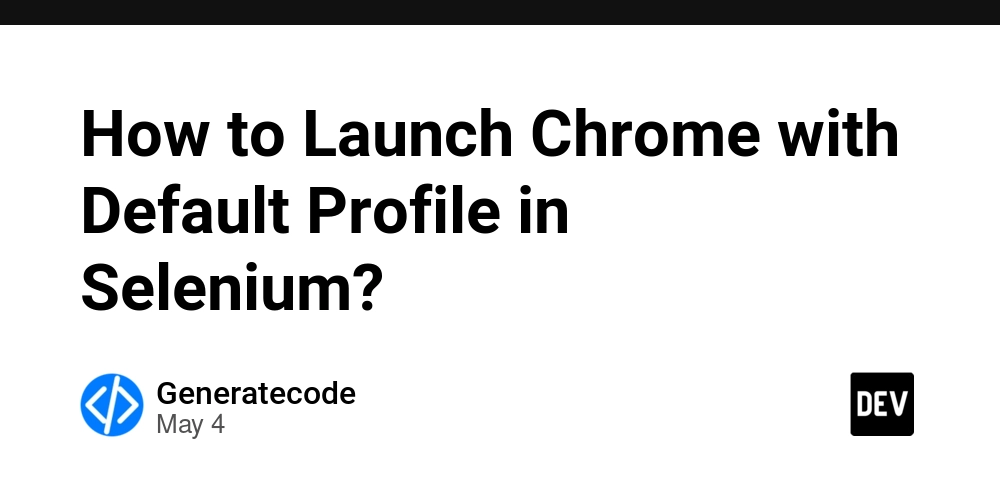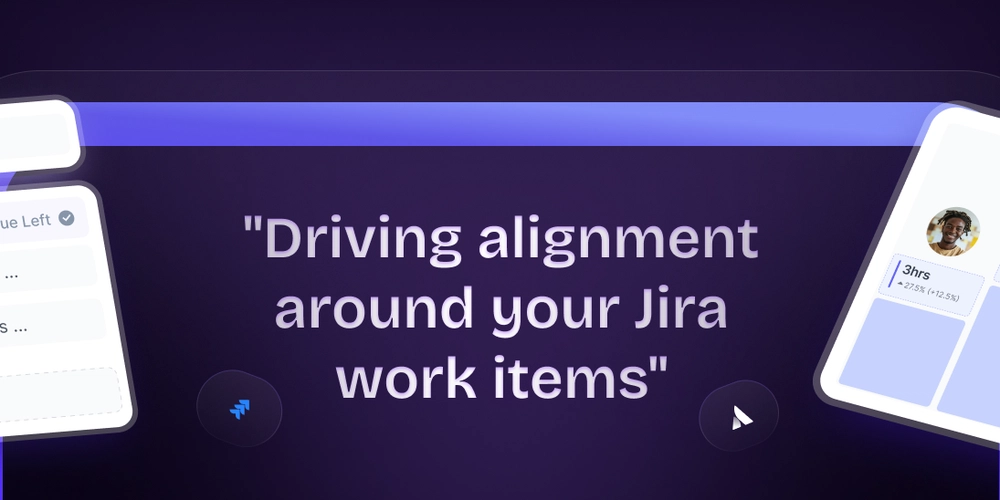How to Launch Chrome with Default Profile in Selenium?
If you're trying to get Selenium to launch Chrome using your default user profile but are facing issues, you are not alone. It's a common problem that many users encounter when automating Chrome browser tasks with Selenium. The good news is that there is a straightforward solution to this issue. In this article, we will discuss how to correctly configure Selenium to use your default Chrome profile. Understanding the Problem When you launch Chrome using Selenium without the correct configuration for your user profile, the browser often starts as a new instance, without any of your profile-specific settings, such as bookmarks, extensions, and saved passwords. This means you'll have a fresh Chrome window that is not logged into any of your accounts or doesn't have your usual settings. The primary reason for this issue lies in how Selenium handles Chrome user data. Selenium needs to be pointed to your specific user data directory in order to load your default profile properly. Step-by-Step Solution to Launch Chrome with Default Profile Let’s walk through the process of launching the Chrome browser with your default profile using Selenium. Prerequisites Before you begin, ensure that: You have Python installed on your machine. You've installed Selenium. If you haven't, you can install it using pip: pip install selenium You have the Chrome WebDriver downloaded and its path added to your system's environment variables. Configuring WebDriver to Use Your User Data Follow the steps below to configure your script: Import the WebDriver: Start by importing the necessary modules from Selenium. Set Up Chrome Options: Use ChromeOptions to specify the user data directory. Launch Chrome: Create an instance of the Chrome driver with your specified options. Here’s a sample code snippet demonstrating how to accomplish this: from selenium import webdriver # Create instance of ChromeOptions options = webdriver.ChromeOptions() # Specify the user data directory path options.add_argument("user-data-dir=C:/Users/Me/AppData/Local/Google/Chrome/User Data") # Launch Chrome with the specified options try: driver = webdriver.Chrome(options=options) except Exception as e: print(f"Error launching Chrome: {e}") # Open Google as a test driver.get('https://google.com/') Key Details Explained User Data Directory: In the code, the path you provide for user-data-dir points to your default Chrome user profile. Make sure to replace C:/Users/Me/AppData/Local/Google/Chrome/User Data with the actual path to your user directory on your machine. No Profile Argument: Unlike other configurations, you do NOT set a specific profile. You only provide the base user data directory from which Chrome pulls your profile data. This ensures that it loads the default settings. Testing Your Configuration Once your script is saved, run it to see if it successfully launches Chrome with your saved user profile. You should see your logged-in accounts, bookmarks, and any saved settings. If Chrome doesn't open with your profile, ensure that the path to the user data directory is correct. Common Issues and Troubleshooting Profile in Use: If you have another instance of Chrome running with that user profile, Selenium will not be able to access it. Always close other Chrome instances before running your Selenium script to avoid conflicts. Incorrect Path: Double-check the path you've specified for user-data-dir. An incorrect path will lead to Chrome launching a new profile. You can find your exact profile directory by navigating to chrome://version/ in a Chrome window. Frequently Asked Questions (FAQ) Can I Use Multiple Profiles with Selenium? Yes, you can specify a particular profile by appending profile-directory= to the options.add_argument method, for example: options.add_argument("profile-directory=Profile 1") Does this method work with other browsers? This method is specifically for Google Chrome. Other browsers like Firefox or Safari have different ways to load profiles, and you should consult their respective documentation for proper configurations. What if Chrome doesn't log in automatically? Ensure that you are logged into Chrome with the profile you specified. If you are logged out, the session won't carry over to Selenium. Conclusion Setting up Selenium to launch Chrome with your default profile can significantly enhance your automation experience by retaining all your preferences and data. By following the steps provided in this tutorial, you can efficiently get your Selenium scripts running with your normal Chrome setup. Remember to always verify your user data path and manage other Chrome instances to have a seamless experience.

If you're trying to get Selenium to launch Chrome using your default user profile but are facing issues, you are not alone. It's a common problem that many users encounter when automating Chrome browser tasks with Selenium. The good news is that there is a straightforward solution to this issue. In this article, we will discuss how to correctly configure Selenium to use your default Chrome profile.
Understanding the Problem
When you launch Chrome using Selenium without the correct configuration for your user profile, the browser often starts as a new instance, without any of your profile-specific settings, such as bookmarks, extensions, and saved passwords. This means you'll have a fresh Chrome window that is not logged into any of your accounts or doesn't have your usual settings.
The primary reason for this issue lies in how Selenium handles Chrome user data. Selenium needs to be pointed to your specific user data directory in order to load your default profile properly.
Step-by-Step Solution to Launch Chrome with Default Profile
Let’s walk through the process of launching the Chrome browser with your default profile using Selenium.
Prerequisites
Before you begin, ensure that:
- You have Python installed on your machine.
- You've installed Selenium. If you haven't, you can install it using pip:
pip install selenium
- You have the Chrome WebDriver downloaded and its path added to your system's environment variables.
Configuring WebDriver to Use Your User Data
Follow the steps below to configure your script:
-
Import the WebDriver: Start by importing the necessary modules from Selenium.
-
Set Up Chrome Options: Use
ChromeOptionsto specify the user data directory. -
Launch Chrome: Create an instance of the Chrome driver with your specified options.
Here’s a sample code snippet demonstrating how to accomplish this:
from selenium import webdriver
# Create instance of ChromeOptions
options = webdriver.ChromeOptions()
# Specify the user data directory path
options.add_argument("user-data-dir=C:/Users/Me/AppData/Local/Google/Chrome/User Data")
# Launch Chrome with the specified options
try:
driver = webdriver.Chrome(options=options)
except Exception as e:
print(f"Error launching Chrome: {e}")
# Open Google as a test
driver.get('https://google.com/')
Key Details Explained
-
User Data Directory: In the code, the path you provide for
user-data-dirpoints to your default Chrome user profile. Make sure to replaceC:/Users/Me/AppData/Local/Google/Chrome/User Datawith the actual path to your user directory on your machine. -
No Profile Argument: Unlike other configurations, you do NOT set a specific profile. You only provide the base user data directory from which Chrome pulls your profile data. This ensures that it loads the default settings.
Testing Your Configuration
Once your script is saved, run it to see if it successfully launches Chrome with your saved user profile. You should see your logged-in accounts, bookmarks, and any saved settings. If Chrome doesn't open with your profile, ensure that the path to the user data directory is correct.
Common Issues and Troubleshooting
-
Profile in Use: If you have another instance of Chrome running with that user profile, Selenium will not be able to access it. Always close other Chrome instances before running your Selenium script to avoid conflicts.
-
Incorrect Path: Double-check the path you've specified for
user-data-dir. An incorrect path will lead to Chrome launching a new profile. You can find your exact profile directory by navigating tochrome://version/in a Chrome window.
Frequently Asked Questions (FAQ)
Can I Use Multiple Profiles with Selenium?
Yes, you can specify a particular profile by appending profile-directory= to the options.add_argument method, for example:
options.add_argument("profile-directory=Profile 1")
Does this method work with other browsers?
This method is specifically for Google Chrome. Other browsers like Firefox or Safari have different ways to load profiles, and you should consult their respective documentation for proper configurations.
What if Chrome doesn't log in automatically?
Ensure that you are logged into Chrome with the profile you specified. If you are logged out, the session won't carry over to Selenium.
Conclusion
Setting up Selenium to launch Chrome with your default profile can significantly enhance your automation experience by retaining all your preferences and data. By following the steps provided in this tutorial, you can efficiently get your Selenium scripts running with your normal Chrome setup. Remember to always verify your user data path and manage other Chrome instances to have a seamless experience.





































































































































































![[The AI Show Episode 145]: OpenAI Releases o3 and o4-mini, AI Is Causing “Quiet Layoffs,” Executive Order on Youth AI Education & GPT-4o’s Controversial Update](https://www.marketingaiinstitute.com/hubfs/ep%20145%20cover.png)




























































































































![[DEALS] Microsoft 365: 1-Year Subscription (Family/Up to 6 Users) (23% off) & Other Deals Up To 98% Off – Offers End Soon!](https://www.javacodegeeks.com/wp-content/uploads/2012/12/jcg-logo.jpg)




![From Art School Drop-out to Microsoft Engineer with Shashi Lo [Podcast #170]](https://cdn.hashnode.com/res/hashnode/image/upload/v1746203291209/439bf16b-c820-4fe8-b69e-94d80533b2df.png?#)




















![Re-designing a Git/development workflow with best practices [closed]](https://i.postimg.cc/tRvBYcrt/branching-example.jpg)




















































































(1).jpg?#)

















![The Material 3 Expressive redesign of Google Clock leaks out [Gallery]](https://i0.wp.com/9to5google.com/wp-content/uploads/sites/4/2024/03/Google-Clock-v2.jpg?resize=1200%2C628&quality=82&strip=all&ssl=1)












_Inge_Johnsson-Alamy.jpg?width=1280&auto=webp&quality=80&disable=upscale#)
































































































![What Google Messages features are rolling out [May 2025]](https://i0.wp.com/9to5google.com/wp-content/uploads/sites/4/2023/12/google-messages-name-cover.png?resize=1200%2C628&quality=82&strip=all&ssl=1)














![New Apple iPad mini 7 On Sale for $399! [Lowest Price Ever]](https://www.iclarified.com/images/news/96096/96096/96096-640.jpg)
![Apple to Split iPhone Launches Across Fall and Spring in Major Shakeup [Report]](https://www.iclarified.com/images/news/97211/97211/97211-640.jpg)
![Apple to Move Camera to Top Left, Hide Face ID Under Display in iPhone 18 Pro Redesign [Report]](https://www.iclarified.com/images/news/97212/97212/97212-640.jpg)
![Apple Developing Battery Case for iPhone 17 Air Amid Battery Life Concerns [Report]](https://www.iclarified.com/images/news/97208/97208/97208-640.jpg)



































































































